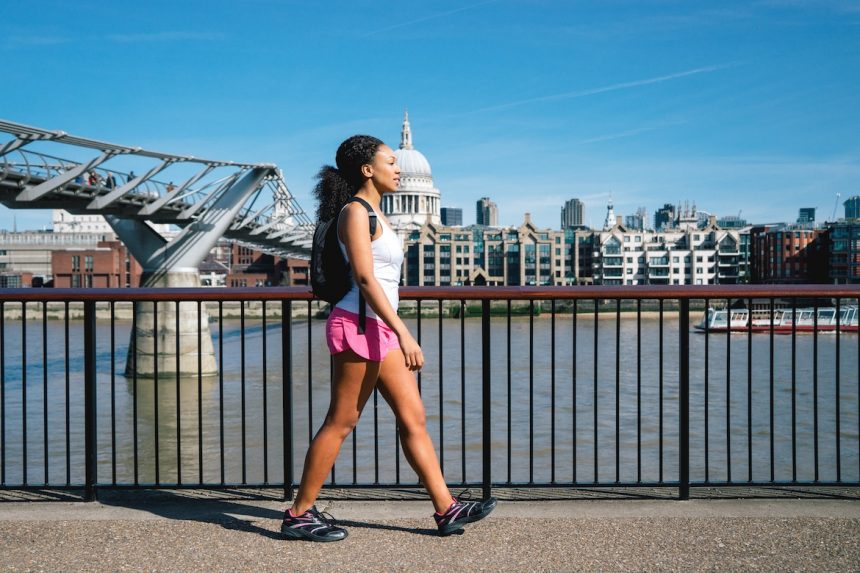“`html
The word “hiking” probably conjures up images of mountains, evergreen trees, crunchy dirt paths, and a respite from the company of other humans. The concept of urban hiking, then, may seem like an oxymoron. Instead of dirt, trees, and quiet, it’s all…cement, stoplights, and car exhaust? But don’t let the initial impression deter you. The benefits of taking an urban hike are as impressive as those of their backcountry counterparts.
The benefits of taking an urban hike are as impressive as those of their backcountry counterparts. “Urban hiking offers a unique blend of outdoor adventure and urban exploration,” says Stephanie Asper, head of social media at trail guide app AllTrails. “It is also a reminder that you don’t actually have to go very far to get outside.” The practice brings the magic of a long, mindful hike close to home, even for those who don’t have the great outdoors anywhere near their doorstep. Urban hiking has gained a steady presence on TikTok and Instagram, as another rebrand of walking alongside hot girl walks and 12-3-30. What’s behind its rise? “We know how important it is to move our bodies in our daily lives, and there’s a growing effort to make fitness and outdoor activity more accessible—and enjoyable—for a wider audience,” Asper says. “Walking and hiking are activities that are accessible to almost everyone, so it’s no surprise that so many social media trends have emerged around them… These trends serve as a reminder that getting outside or moving your body doesn’t have to be too complicated.”
Related Stories Intrigued? Grab your trail mix. Here’s how to get started with urban hiking, and why it’s worth a try.
What is urban hiking?
Simply put, urban hiking is “a form of walking or hiking that takes place within a city, rather than in a natural or typical hiking setting like a forest or mountain,” says Nichele Cihlar, CSCS, director of training at the rucking gear company GORUCK. “Similar to traditional hiking, you’re still walking, which is a great form of physical activity. You’re also still able to explore different parts of nature such as parks and green spaces even if you’re in an urban environment.” Really, the concept of urban hiking helps redefine the idea of what a hike is, Asper adds. A hike doesn’t require visiting a national park or donning serious hiking boots. “It really can be as simple as just a long walk,” she says.
What makes it different from other walking trends, then, like hot girl walks? In many cases, urban hiking involves longer distances, some sort of destination (whether a coffee shop, park, or pretty view), and a more mindful approach. That is, it’s often done without listening to music or a podcast and with a greater emphasis on exploration and appreciating the world around you. Take it from Seattle-based Sara Anfuso (aka @servedbysara), who shares recaps of her urban hikes and long-distance walks on Instagram and TikTok. She used to take regular morning walks with her dad and then, in 2017, went on a school trip to walk the French route of the Camino de Santiago. During her training and experience on the Camino, she fell in love with the practice of long-distance walking (LDW). “I love how meditative it is, how it allows for mental clarity, and time to just think,” she says.
The benefits of urban hiking
Urban hiking is a form of low-impact exercise that comes with many benefits, including improving cardiovascular health, strengthening muscles, and promoting overall fitness, Cihlar says. Low-impact means you’re not putting much stress on your joints, making it friendlier to beginners or those with injuries compared to high-impact activities like running. It’s a pretty great workout, too. Walking at a brisk pace for at least 150 minutes a week can help you sleep better, increase energy, improve blood pressure, blood sugar, and blood cholesterol levels, improve mental health and cognition, boost bone strength, and reduce your risk of serious diseases like heart disease, stroke, diabetes, and cancer, according to the American Heart Association.
If you’re walking at a 20-minute-mile pace, you could log that by walking a little over a mile every day or going for two longer walks of about four miles each. If you want to amp up the physical benefits of an urban hike, try carrying weight on your back (aka rucking), Cihlar says. You can do it by wearing a weighted vest or rucksack, or simply by carrying a backpack stashed with water, snacks, and extra layers, just like you might carry on a traditional hike. Adding weight via a pack or backpack can increase the challenge of your walk, improving aerobic capacity and increasing strength in your lower-body and core muscles, according to the American Council on Exercise.
Urban hiking has mental health benefits, too. “Mentally, urban hiking offers a chance to de-stress and unwind amidst the hustle and bustle of city life, providing a connection to nature even in an urban setting,” Asper says. “Exploring new neighborhoods and discovering new trails can boost curiosity and creativity and give us new appreciation for the diversity and beauty in our everyday places.”
If you can find your way into a park or other green space in your city, you can reap even more mental health perks. Walking in natural environments, including urban green spaces like parks, offers improvements in brain function, psychosocial health, and physical health, including heart rate variability, an important biomarker for stress and anxiety, according to a 2022 study in Cities & Health.
How to get started with urban hiking
Another big benefit of urban hiking is just how easy it is to get started. “Urban hiking makes spending time outside more accessible—it removes barriers of travel and logistics that can be costly, time-consuming, or unavailable to people with disabilities,” Asper says. It’s perhaps the easiest and most economical form of exercise you can do, Cihlar adds: “Just step outside, start walking, and see what your city has to offer.” You can leave your house with the sole purpose of going on an urban hike, or use the practice as an alternative (and greener) means of transportation. For example, you can urban hike to work, an appointment, a coffee shop, or lunch instead of driving a car, Cihlar says. Walking instead of driving or biking allows you to go slower and enjoy your surroundings. It’s also fun to motivate yourself by walking to a picturesque view or to try a new brewery, for example.
“`






